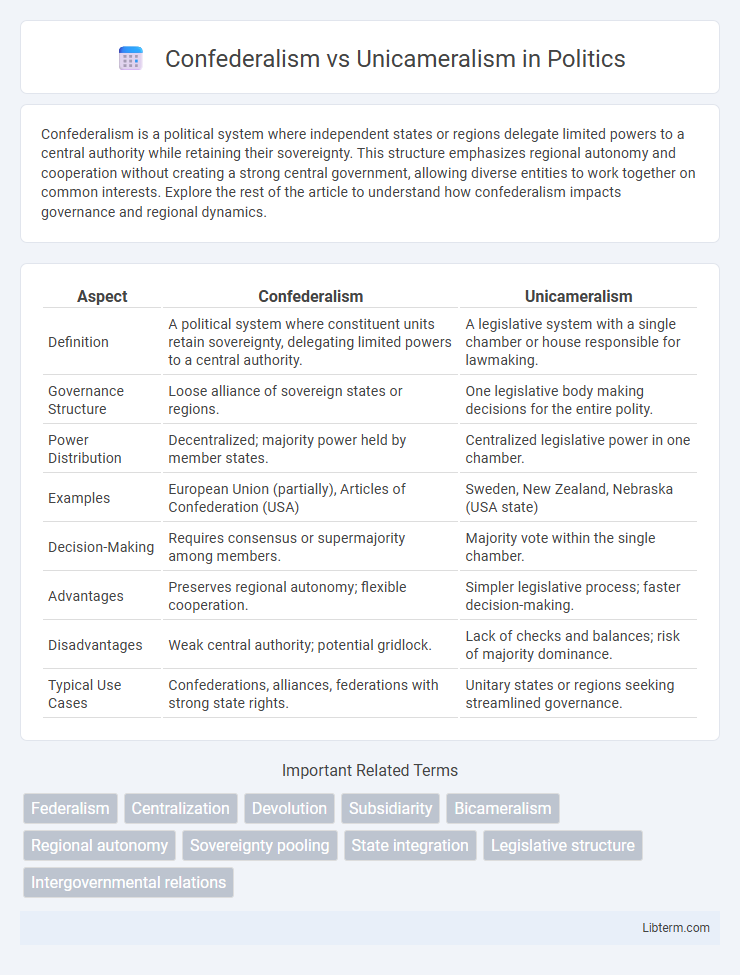Confederalism is a political system where independent states or regions delegate limited powers to a central authority while retaining their sovereignty. This structure emphasizes regional autonomy and cooperation without creating a strong central government, allowing diverse entities to work together on common interests. Explore the rest of the article to understand how confederalism impacts governance and regional dynamics.
Table of Comparison
| Aspect | Confederalism | Unicameralism |
|---|---|---|
| Definition | A political system where constituent units retain sovereignty, delegating limited powers to a central authority. | A legislative system with a single chamber or house responsible for lawmaking. |
| Governance Structure | Loose alliance of sovereign states or regions. | One legislative body making decisions for the entire polity. |
| Power Distribution | Decentralized; majority power held by member states. | Centralized legislative power in one chamber. |
| Examples | European Union (partially), Articles of Confederation (USA) | Sweden, New Zealand, Nebraska (USA state) |
| Decision-Making | Requires consensus or supermajority among members. | Majority vote within the single chamber. |
| Advantages | Preserves regional autonomy; flexible cooperation. | Simpler legislative process; faster decision-making. |
| Disadvantages | Weak central authority; potential gridlock. | Lack of checks and balances; risk of majority dominance. |
| Typical Use Cases | Confederations, alliances, federations with strong state rights. | Unitary states or regions seeking streamlined governance. |
Introduction to Confederalism and Unicameralism
Confederalism is a political system where sovereign states delegate limited powers to a central authority, emphasizing regional autonomy and decentralized governance. Unicameralism refers to a legislative structure with a single chamber responsible for lawmaking, streamlining the decision-making process and reducing legislative complexity. Both concepts shape governance, with confederalism influencing the distribution of power and unicameralism affecting legislative efficiency.
Defining Confederalism: Structure and Principles
Confederalism is a political system where multiple sovereign states form a union while retaining their independence, characterized by a decentralized framework and limited central authority primarily responsible for common interests like defense and trade. Its structure emphasizes strong regional autonomy with decision-making powers concentrated in constituent states rather than a central government, contrasting with unitary or federal systems. The principle of confederalism ensures that the central body's authority derives from and can be revoked by the member states, highlighting voluntary cooperation and collective action without overriding state sovereignty.
Understanding Unicameralism: Key Features
Unicameralism centers on a single legislative chamber, streamlining the lawmaking process by eliminating the need for approval from multiple houses. This system enhances legislative efficiency and accountability by concentrating authority in one body, reducing potential conflicts seen in bicameral structures. Unicameral legislatures are often favored in smaller or more homogeneous states for their simplicity and direct representation.
Historical Evolution of Confederal Systems
Confederalism's historical evolution traces back to early political structures like the Swiss Confederation of 1291 and the Articles of Confederation in the United States (1781-1789), where independent states retained sovereignty while cooperating on common interests. Unlike unicameralism, which denotes a single legislative chamber, confederal systems emphasize decentralized governance with member states exercising significant autonomy. The persistent challenge in confederalism has been balancing state sovereignty with effective collective decision-making, a theme evident in the formation of the European Union's confederal elements.
Unicameral Legislatures: Global Examples
Unicameral legislatures streamline lawmaking by concentrating authority in a single parliamentary chamber, as seen in countries like Denmark, New Zealand, and Sweden. These governments benefit from faster legislative processes and clearer accountability compared to bicameral systems, which distribute power across two chambers. The trend toward unicameralism is linked with smaller, more centralized states seeking efficiency and simplicity in governance.
Power Distribution: Confederalism vs Unicameralism
Confederalism centralizes power within independent states that retain sovereignty while delegating limited authority to a weak central government, emphasizing state autonomy in decision-making. Unicameralism concentrates legislative power in a single parliamentary chamber, streamlining lawmaking but potentially reducing regional representation and checks on authority. The key distinction lies in confederalism's structural division of power among states versus unicameralism's consolidation of legislative power within one body.
Decision-Making Processes Compared
Confederalism features decentralized decision-making where sovereign states retain authority and collaborate on common issues, often requiring consensus or supermajority votes for policies. Unicameralism centralizes legislative power in a single chamber, streamlining decision-making through majority rule and faster law enactment. The confederal model often results in slower, more deliberate decisions to respect state autonomy, whereas unicameral legislatures prioritize efficiency and unified governance.
Advantages of Confederalism
Confederalism offers enhanced regional autonomy by allowing member states to retain sovereignty while cooperating on common issues, which fosters tailored governance suited to local needs. It promotes political stability through voluntary association, reducing the risk of centralized authoritarianism and encouraging peaceful conflict resolution among diverse groups. Economic collaboration within a confederal system enables shared resources and coordinated policies without imposing uniform regulations, benefiting regional development.
Benefits and Challenges of Unicameralism
Unicameralism streamlines the legislative process by consolidating law-making authority into a single chamber, enhancing efficiency and reducing administrative costs. This structure fosters greater transparency and accountability as there is only one body responsible for legislative decisions, simplifying citizen engagement. However, unicameral systems may face challenges like limited checks and balances, which can concentrate power and reduce the opportunities for comprehensive debate and review compared to bicameral or confederal systems.
Confederalism vs Unicameralism: Which is Best for Governance?
Confederalism emphasizes the sovereignty of individual member states within a loose alliance, promoting local autonomy and limiting central authority, whereas unicameralism features a single legislative chamber that streamlines lawmaking and reduces redundancy. Confederal systems suit diverse regions prioritizing decentralized governance, while unicameral systems enhance legislative efficiency in more unified political entities. Governance effectiveness depends on balancing state sovereignty against streamlined legislative processes to meet specific political and social contexts.
Confederalism Infographic

 libterm.com
libterm.com